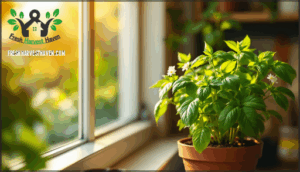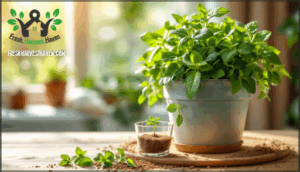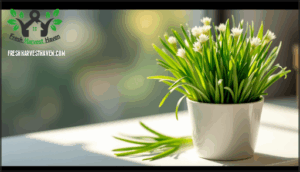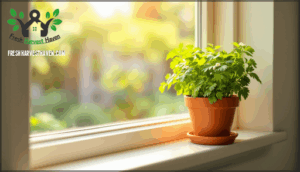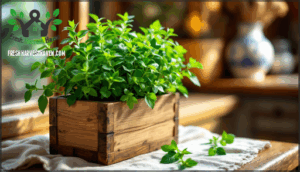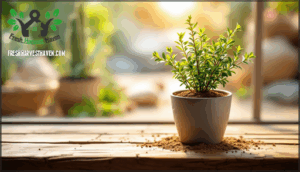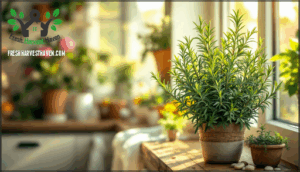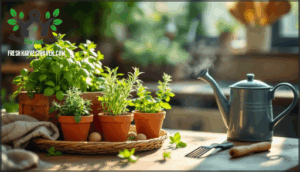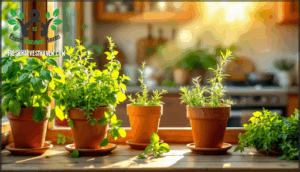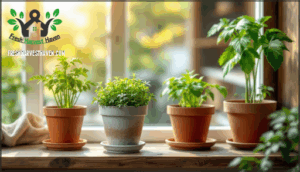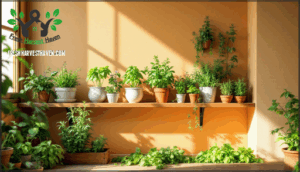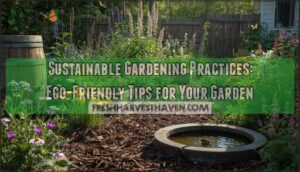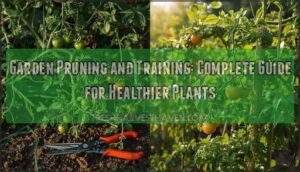This site is supported by our readers. We may earn a commission, at no cost to you, if you purchase through links.
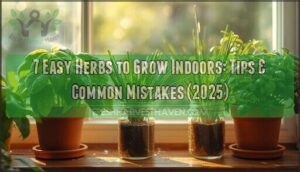 You don’t need a backyard to grow fresh herbs. A sunny windowsill, the right containers, and five minutes of daily attention turn your kitchen into a year-round herb garden.
You don’t need a backyard to grow fresh herbs. A sunny windowsill, the right containers, and five minutes of daily attention turn your kitchen into a year-round herb garden.
Basil, mint, and chives thrive indoors with minimal fuss, giving you fresh flavors without trips to the grocery store. The key is matching each herb’s needs to your space—some tolerate low light while others demand direct sun.
Get the basics right, and you’ll harvest fresh leaves for months without starting over.
Table Of Contents
- Key Takeaways
- Easiest Herbs to Grow Indoors
- Essential Supplies for Indoor Herb Gardens
- Ideal Growing Conditions for Indoor Herbs
- Common Mistakes to Avoid When Growing Herbs
- Tips for Thriving Indoor Herb Gardens
- Frequently Asked Questions (FAQs)
- Are herbs easy to grow indoors?
- What are some indoor herb garden ideas?
- What are indoor herbs for beginners?
- What makes herbs so valuable for indoor space?
- Is Basil a good indoor herb garden?
- What are the best herbs to use in a home?
- What herbs are low maintenance to grow?
- Can herbs grow in windowless rooms?
- Which herbs need the least maintenance?
- How often should indoor herbs be repotted?
- Conclusion
Key Takeaways
- Most indoor herbs need 6–8 hours of direct sunlight daily, but mint tolerates lower light better than basil, so match your herbs to your available light before you plant.
- Overwatering kills more indoor herb gardens than any other mistake—check soil moisture with your finger before watering, and use containers with drainage holes to prevent root rot.
- Basil, mint, chives, thyme, and oregano are the easiest herbs for beginners because they’re forgiving about watering schedules and bounce back quickly after harvesting.
- Regular pruning and harvesting trigger bushier growth and continuous leaf production, transforming leggy plants into full, productive herbs that keep your kitchen stocked year-round.
Easiest Herbs to Grow Indoors
Growing herbs indoors doesn’t require a green thumb—just the right picks. Some herbs tolerate low light, dry air, and beginner mistakes better than others.
Here’s a breakdown of seven forgiving favorites that’ll thrive on your windowsill.
Basil – Light and Care Needs
Basil tops the list for indoor herb gardening, but it demands serious light—aim for 6 to 8 hours of direct sun daily or place it under LED grow lights. You’ll also need to dial in your watering and soil quality to keep those leaves lush.
- Position your basil near south or east-facing windows for maximum leaf production
- Water every 2 to 4 days, checking the top inch of soil stays moist but not soggy
- Maintain temperatures between 70°F and 85°F for vigorous indoor growth
- Use well-draining potting mix to prevent root rot and support water balance
To achieve ideal growth, consider using indoor garden tips to create a thriving environment.
Mint – Potting and Growth Habits
Mint grows like wildfire once it settles in, so you’ll want to give it its own roomy pot—trust me, it’ll take over every neighboring herb if you let it. Use a well-draining potting mix and water when the top inch dries out.
This herb bounces back fast after leaf harvest and tolerates lower light better than basil. Mint propagation is simple—just snip a stem and root it in water for your indoor herb garden.
Chives – Space-Saving and Harvesting
Chives fit beautifully in tight spaces—you can tuck a small pot on a windowsill or countertop corner without feeling like you’re running a greenhouse. Their Space Saving design makes them perfect for Windowsill Herb Gardening enthusiasts.
Chive Care basics for your Indoor Herb Garden:
- Trim regularly to encourage Chive Regrowth and prevent flowering
- Cut about an inch above the soil during Indoor Trimming sessions
- Harvest often as part of your Herb Garden Maintenance routine
Growing Herbs Indoors gets easier when you know these Harvest Tips—frequent trimming keeps Chives productive and compact.
Parsley – Sunlight and Watering Tips
Parsley takes its time getting started, but once it’s settled in, you’ll want to get the light and water just right to keep those flavorful leaves coming. Your Indoor Herb Garden thrives with six hours of sunlight daily—place Parsley near a bright window for strong Leaf Production.
Keep Soil Moisture consistent but not soggy, as Water Balance matters at all Growth Stages of Herb Plant Care. Windowsill Herb Gardening success means checking moisture before watering again.
Oregano – Low-Maintenance Requirements
Oregano practically runs itself—this hardy herb forgives forgotten waterings and keeps producing aromatic leaves with barely any fuss. Oregano Care is simple: six hours of light (though it tolerates Low Light Options), well-draining soil, and minimal Herb Fertilizers.
Growing Herbs at Home means harvesting often for Greek Recipes while checking for Indoor Pests. Herb Care and Maintenance doesn’t get easier for Indoor Gardening for Beginners.
Thyme – Soil and Drought Tolerance
Thyme laughs at neglect—this Mediterranean workhorse thrives in sandy, fast-draining soil and actually prefers life on the dry side.
Thyme Care means letting Soil Quality dry between waterings to maintain Water Balance and Root Health. This Drought Resistance makes Thyme perfect for your Indoor Herb Garden when you’re mastering Herb Gardening for Beginners, Growing Herbs Indoors, and Herb Care and Maintenance.
Rosemary – Airflow and Light Preferences
Rosemary demands bright light and breathing room—six hours of direct sun and good airflow keep this woody herb from sulking or developing mildew. Position your Rosemary near a south-facing window for ideal Light Intensity in your Indoor Herb Garden.
Proper Air Circulation prevents fungal problems while releasing Fragrance Benefits throughout your space.
Regular Pruning Tips: snip stems frequently for bushier Indoor Gardening success and stronger Growing Herbs Indoors results with focused Herb Gardening Tips and Rosemary Care.
Essential Supplies for Indoor Herb Gardens
You don’t need much to start your indoor herb garden, but choosing the right supplies makes all the difference. The basics—containers, soil, light, and a few simple tools—set you up for success from day one.
Here’s what you need to grow fresh herbs right in your kitchen.
Best Containers and Drainage Solutions
Your container choice can make or break your indoor herb garden before you even plant a single seed. Here’s what you need to get it right:
- Pick terracotta or ceramic pots – they allow roots to breathe and prevent waterlogged soil
- Drainage holes are non-negotiable – without them, you’re setting up your herbs for root rot
- Size matters for container herb gardening – choose pots at least 6-8 inches deep for healthy root systems
Good water management starts with smart container gardening ideas that prioritize airflow and drainage systems.
Choosing The Right Potting Soil
Think of potting soil as the foundation of your indoor herb empire—get it wrong, and even the hardiest basil will struggle. You need well-drained potting mix with organic matter, not garden soil that compacts and suffocates roots.
| Soil Quality Factor | What Your Herbs Need |
|---|---|
| Soil Composition | Loose, aerated potting mix for container gardening |
| Organic Matter | Compost or peat for nutrient retention |
| pH Levels | 6.0-7.0 range accommodates most herb plant care |
| Fertilizer Types | Slow-release formulas for indoor herb gardening |
Lighting Options for Indoor Herbs
Natural light from a south-facing windowsill remains your best bet—herbs need at least 6 hours of direct sunlight daily.
When windows fall short, LED grow lights deliver targeted wavelengths (blue for leafy growth, red for flavor) using 40–60% less energy than fluorescent options. Position LEDs 12–14 inches above your herbs and run them 12–16 hours daily for thriving indoor herb gardening.
Understanding the indoor grow lights is essential for ideal herb growth and quality.
Tools for Planting and Maintenance
Once you’ve got your light dialed in, you’ll need a few basic tools to get your plants in the ground and keep them thriving. Start with pruning shears for regular trimming, a small trowel for planting, and plant labels to track varieties.
Add a basic soil tester to monitor moisture levels, and you’re set for successful plant care and fertilization without guesswork.
Ideal Growing Conditions for Indoor Herbs
Your herbs won’t just survive—they’ll thrive when you nail the basics. Getting light, water, temperature, and feeding right means the difference between scraggly stems and a lush indoor garden that keeps your kitchen stocked year-round.
Here’s what your herbs actually need to flourish indoors.
Light Requirements and Placement
Most indoor herbs need 6 to 8 hours of direct sunlight daily to thrive. South-facing windowsills deliver the strongest light intensity, while east-facing windows work for less demanding herbs like mint.
If natural light falls short, use full-spectrum LED grow lights positioned 6 to 12 inches above plants for 14 hours daily.
Rotate containers every few days to prevent lopsided growth from uneven sunlight exposure.
Watering Schedules and Humidity Control
Too much water drowns roots, too little leaves plants gasping—getting it right keeps your herbs alive and flavorful. Check soil moisture by sticking your finger an inch deep—water only when it feels dry.
Most indoor herbs need watering every 2 to 3 days, but watering cycles vary with evaporation rates and humidity levels.
Boost humidity control around basil and mint by misting leaves or placing containers on pebble trays filled with water.
Temperature and Air Circulation Needs
Your herbs won’t forgive a cold draft or stale air—they need steady warmth and good airflow to prevent weak stems and fungal problems. Keep daytime temperatures between 65°F and 70°F for climate regulation that fosters indoor herbs.
Place plants away from heating vents and open windows to avoid temperature swings. A small fan improves air flow management and ventilation systems naturally, strengthening stems while preventing moisture buildup that invites disease in your windowsill gardening setup.
Fertilizing Basics for Healthy Growth
Most indoor herbs drain potting soil nutrients within 4 to 6 weeks, so a light feeding schedule keeps your basil, mint, and thyme producing flavorful leaves instead of fading into pale shadows of themselves. Use a diluted herb fertilizer or compost tea every two weeks to support nutrient cycling without overwhelming microbial health in your indoor herb garden.
- Choose organic fertilizers to maintain soil pH balance naturally
- Apply half-strength solutions during fertilization to prevent nutrient burn
- Monitor leaf color—pale growth signals it’s time to feed
- Skip fertilizing newly transplanted herbs for three weeks while roots establish
Common Mistakes to Avoid When Growing Herbs
Even experienced gardeners hit roadblocks when they bring herbs indoors. You’ll avoid frustration and dead plants by knowing what traps to sidestep before they happen.
Here’s what kills most indoor herb gardens—and how you can stop it.
Overwatering and Poor Drainage
Waterlogged soil is one of the fastest ways to kill your indoor herbs. Overwatering accounts for over 70% of houseplant failures, creating oxygen-starved roots that quickly develop root rot. Without proper drainage holes, excess water pools at the bottom and suffocates root systems within 24 hours.
You’ll notice yellowing leaves, wilting stems, or even a rotten smell.
Choose containers with drainage holes, test soil moisture by finger before watering, and use well-aerated potting mix with perlite for better moisture control and healthier herb garden maintenance.
Insufficient Sunlight Exposure
When light levels drop below what your herbs need, they’ll stretch toward any available source and end up leggy, pale, and practically flavorless. Most herbs demand around 6 hours of direct sunlight daily to support proper photosynthesis needs.
South-facing windows work best for indoor herb gardens, but if sunlight deficiency is an issue, grow light options running 14–16 hours can compensate.
Don’t ignore shade tolerance—herbs like mint tolerate lower indoor lighting better than basil.
Overcrowding Plants in Containers
Cramming too many herbs into one pot is like packing five people into a phone booth—things get uncomfortable fast, and nobody thrives. Root bound plants compete for nutrients, stunting growth, and poor air circulation invites disease.
Container size matters—give each herb 2–3 inches of plant spacing to maintain soil quality. Proper container gardening techniques guarantee your herb garden maintenance efforts pay off with vigorous indoor plant care results.
Neglecting Regular Pruning and Harvesting
Skip the pruning shears, and your herbs will stretch tall, thin, and weak—sacrificing flavor and vigor for leggy, unproductive stems. Regular pruning herbs triggers leaf regrowth and plant renewal, keeping your indoor herb garden productive.
Harvest timing and consistent stem maintenance guarantee growing herbs indoors stays rewarding. Smart pruning schedules transform herb garden maintenance from optional to essential for continuous herb planting and pruning success.
Mixing Incompatible Herbs Together
Toss mint in a pot with basil or thyme, and you’ll watch one bully push the others out—some herbs share space, but others wage silent territorial wars. Herb pairing demands matching growth habits and soil compatibility—aggressive spreaders need separate containers for effective space management.
Your indoor herb garden thrives when you respect each plant’s needs, preventing fragrance issues and competition that compromise herb garden maintenance. Smart indoor gardening means understanding growing herbs indoors requires thoughtful separation for lasting herb gardening success.
Tips for Thriving Indoor Herb Gardens
You’ve already dodged the worst mistakes—now it’s time to take control and make your herbs thrive. A few smart techniques can transform struggling plants into lush, productive powerhouses that keep your kitchen stocked year-round.
Here’s how to boost growth, prevent problems, and get the most flavor from every leaf.
Pruning Techniques for Bushier Herbs
Pinching back the growing tips on your herbs is the fastest way to turn a leggy, sparse plant into a full, bushy powerhouse. Focus on stem cutting just above a leaf node—that’s where new branches emerge.
Pinch back growing tips just above leaf nodes to transform leggy herbs into full, bushy powerhouses that produce more flavor per plant
Regular leaf trimming and pinch pruning redirect energy into lateral growth rather than vertical stretching.
This simple herb garden maintenance practice transforms your indoor gardening setup, giving you denser foliage and more flavor per square inch.
Harvesting for Continuous Growth
Once you’ve mastered the art of shaping your plants, you need to harvest them the right way—because how you cut determines whether your herbs keep pumping out fresh growth or slowly fade away. Harvest timing matters—cut in the morning after dew dries for peak flavor.
Use stem pruning above leaf nodes to trigger leaf regrowth and strengthen root development. Snip off flowers immediately for flower control, keeping energy focused on foliage during growing herbs indoors routines.
Pairing Herbs for Space Efficiency
You don’t need a big windowsill to grow a full herb garden—pair your plants smart, and you’ll fit more flavor into less space. Herb pairing and compact planting let you optimize space saving without sacrificing yield in your indoor herb garden.
- Stack herbs in vertical gardens for triple the growing area
- Combine shallow-rooted chives with deep-rooted parsley in one pot
- Group Mediterranean herbs (thyme, oregano, rosemary) for shared watering needs
- Use tiered containers for herb combinations that love identical light
Pest Prevention and Natural Remedies
Even smart pairing won’t protect your herbs from pests—that’s where pest control and garden sanitation take over. Check new plants before bringing them home, cutting pest control and prevention issues by 70%.
Keep air moving with a small fan to drop humidity and discourage fungus gnats. Yellow sticky traps catch whiteflies fast, while neem oil (88% effective in trials) manages aphids without harsh chemicals.
Daily water sprays dislodge bugs naturally, keeping your indoor herb garden clean and thriving with natural remedies.
Maximizing Freshness for Cooking
Fresh herbs lose their punch fast—harvest right before cooking to lock in maximum flavor and essential oils. Snip leaves in the morning after dew dries for peak potency.
Store stems in water like cut flowers—your fresh herbs stay crisp for days.
Use herb pairings in meal planning to simplify cooking with fresh herbs from your kitchen herbs setup.
Frequently Asked Questions (FAQs)
Are herbs easy to grow indoors?
Most herbs thrive indoors with basic gardening knowledge. Indoor climate control, proper soil quality, and space optimization make herb gardening surprisingly manageable.
Choose herbs suited to your indoor environment for best results.
What are some indoor herb garden ideas?
Indoor herb gardens work beautifully in vertical gardens, window planters, or tiered shelving.
Try pairing herbs with similar needs for space optimization—rosemary with thyme, or basil with oregano in separate containers.
What are indoor herbs for beginners?
Starting an indoor herb garden beats buying wilted groceries. Basil, mint, chives, and parsley are ideal beginner herbs requiring minimal care. These starter plants thrive in kitchen windows with a basic indoor gardening for beginners setup—just soil, containers, and sunlight.
Herb selection matters: choose forgiving varieties for gardening basics success. Your indoor spaces transform into fresh herb sources year-round.
What makes herbs so valuable for indoor space?
Growing herbs indoors puts fresh harvests at your fingertips year-round. You’ll save money, enjoy air purification benefits, and optimize space efficiency in even small apartments.
Their low-maintenance nature and aromatic benefits make indoor gardening simple and rewarding for anyone.
Is Basil a good indoor herb garden?
Basil is an excellent choice for indoor gardening. It thrives with proper light and care, making it one of the easiest fragrant herb varieties to cultivate in small spaces.
Regular harvesting keeps your kitchen herb garden productive year-round.
What are the best herbs to use in a home?
The best aromatic choices for your kitchen include basil for Italian dishes, mint for beverages and desserts, thyme for hearty flavors, parsley as a flexible garnish, and chives for mild onion notes.
These culinary household favorites thrive indoors with minimal care, giving you fragrant options year-round.
What herbs are low maintenance to grow?
Like weeds that thrive without fussing, mint, thyme, and chives demand minimal attention. These beginner herbs tolerate inconsistent watering and imperfect light. Oregano’s equally forgiving, bouncing back quickly after harvesting. They’re your gateway to indoor gardening success.
Can herbs grow in windowless rooms?
Absolutely. Indoor grow lights make windowless gardening viable. LED options work well for low light herbs like mint and parsley. Position lights 6–12 inches above plants, running them 14–16 hours daily. This indoor gardening technique replicates sunlight, supporting year-round herb cultivation without natural windows.
Which herbs need the least maintenance?
If you’re after herb garden freedom with zero fuss, mint, chives, and thyme are your champions. They’re forgiving souls—tolerating imperfect light, bouncing back after harvesting, and thriving on neglect.
Mint manages dim corners. Chives spread reliably in tight spaces. Thyme actually prefers drier soil, so you can’t kill it through overwatering.
These low-maintenance herbs deliver fresh flavor without demanding your constant attention.
How often should indoor herbs be repotted?
Repot your indoor herbs every 12 to 18 months or when roots emerge from drainage holes. This soil refresh prevents root bound conditions and transplant shock.
Use a pot size just slightly larger—usually one to two inches wider—to avoid excess moisture retention that weakens herbs indoors.
Conclusion
Imagine starting with a single basil plant on your kitchen windowsill—within weeks, you’re snipping fresh leaves for dinner. Growing easy herbs to grow indoors transforms how you cook and eat.
You’ve eliminated grocery store trips, controlled what touches your food, and reclaimed your space. The herbs won’t abandon you if you forget a day. They’ll thrive with consistent light, proper drainage, and your attention.
Your kitchen garden becomes a daily ritual, not a burden.

